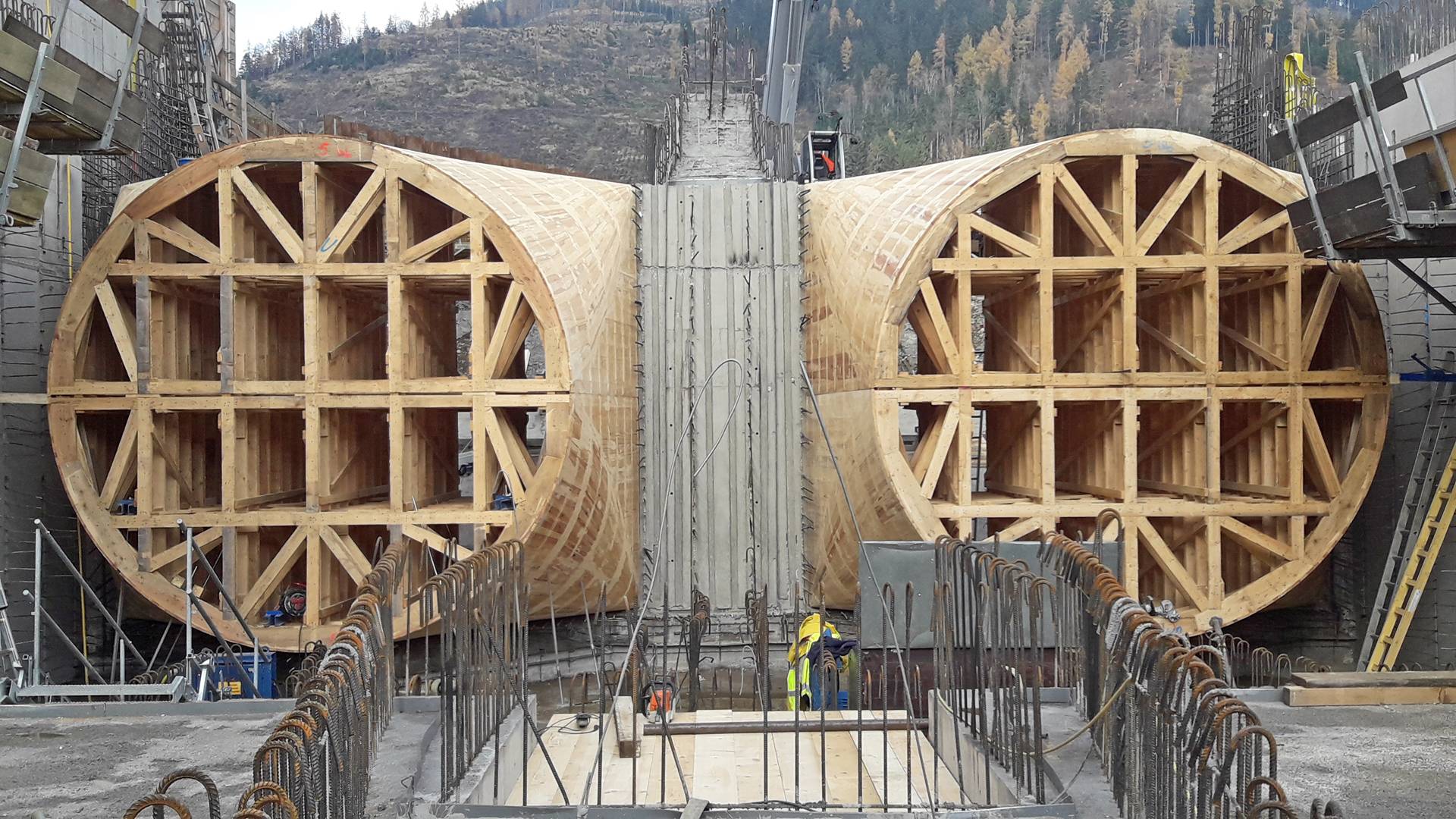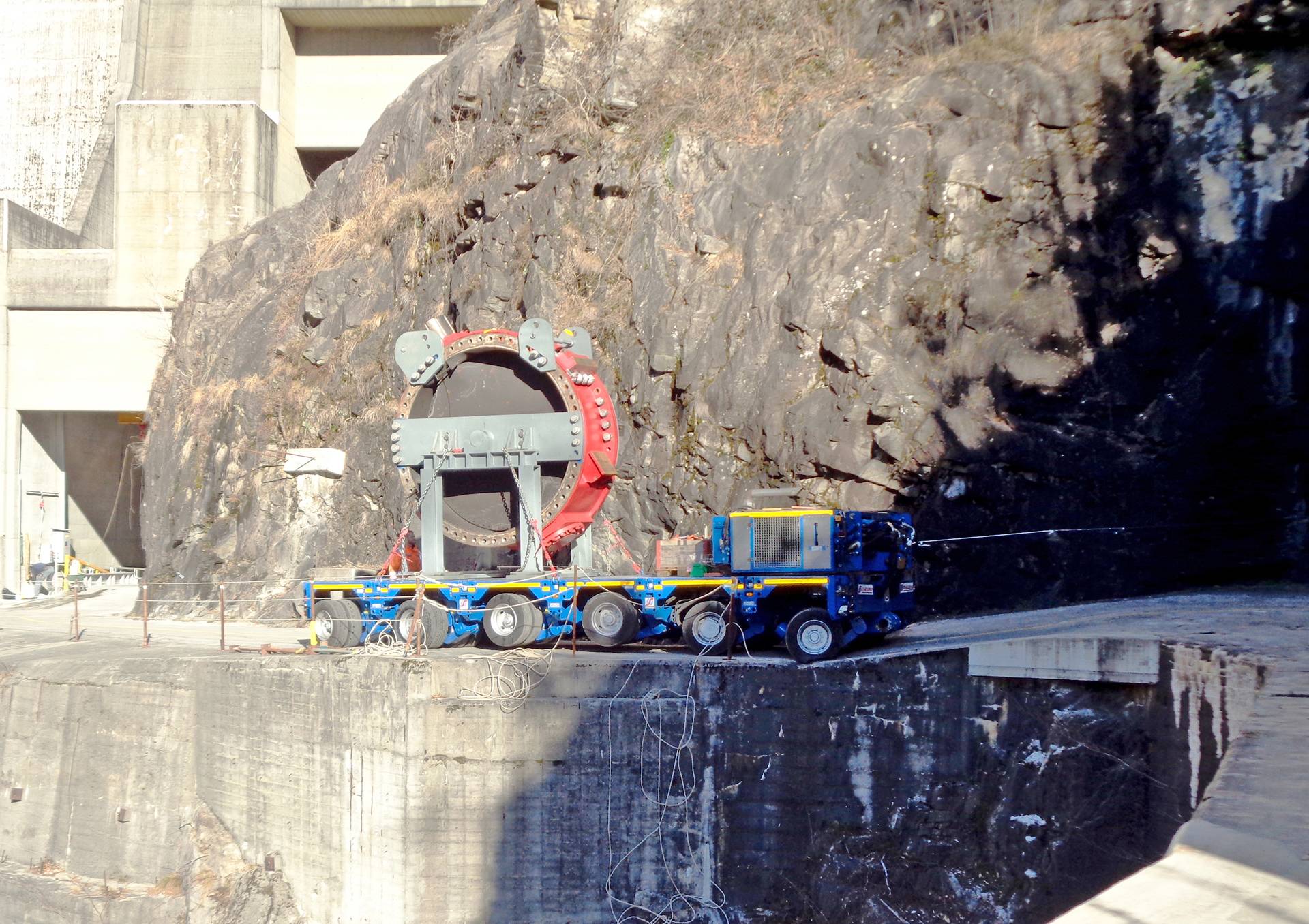Kaplan EVO – rethinking the Kaplan turbine with the bigger picture in mind11 min read
Lesedauer: 8 MinutenIn nature, evolutionary changes usually take place incrementally, although their effects can be enormous. While developing the new ‘EVO’ turbine series, the Upper Austrian hydropower all-rounders at Global Hydro Energy GmbH subjected their Pelton, Francis, and Kaplan turbines to a complete rethink, adapting and optimising them to meet the very latest requirements in terms of environmental protection, economic efficiency and ease of maintenance. The new Kaplan EVO is the centrepiece of the promising modular shaft power plant – a further development of the patent power plant concept created by the Technical University of Munich. It’s an independent Kaplan turbine system that opens up new perspectives for previously unexploited low-head sites. The Kaplan EVO is predestined for use in both refurbishment projects, and all existing transversely-built low-head structures.
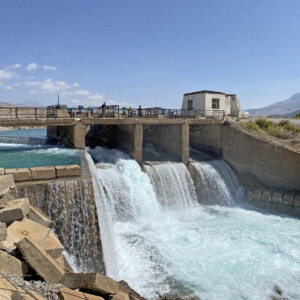
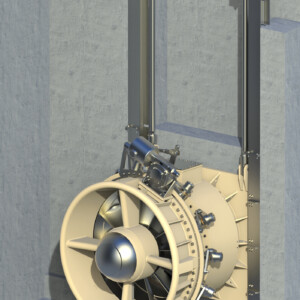
Exploitation of hydropower in the 21st century comes with a whole new set of requirements. Usage of the very oldest form of renewable energy in the modern age necessitates the questioning, and possible revision of, some of the initial premises of the first hydropower boom. The days of mega-power mechanical engineering are definitely over. Today, infrastructural considerations revolve around questions of economic efficiency, environmental friendliness, tradability and controllability. On that note, high performance is a prerequisite for less established manufacturers, too. However, there is only acceptance for technologies that meet today’s wide-ranging water ecology and environmental protection requirements, and can be generally presented as designed to be economically viable and user-friendly. It’s no surprise the renowned hydropower company Global Hydro Energy GmbH has picked up the gauntlet of completely rethinking the machinery in the three most important types of turbines. These Upper Austrian hydropower specialists have created a brand-new line – the EVO series, putting their Pelton, Kaplan, and Francis turbines through technical developments that amount to a genuine evolutionary breakthrough. While the Pelton EVO (see report in zek HYDRO Oct. 2022) was primarily optimised in terms of compactness, simplicity and ease of maintenance, and improvement of the Francis EVO focused on an expansion of the characteristic datapoint fields, the Kaplan EVO was specifically enhanced in the fields of environmental friendliness and ease of maintenance, achieving a previously unheard-of standard of economy in terms of low-head range efficiency.
Showcase for Central Asia
“The roots of the development of Kaplan EVO are to be found in the shaft power plant.” The trend-setting concept of a small and completely submerged power plant was developed by the Technical University of Munich. In short, the most obvious advantages of this power plant set-up are that it is extremely fish-friendly, easily passes on bedloads and debris transported by the river, and is minimally invasive as regards its effects upon the landscape, since the vast majority of the hydropower infrastructure is located under water. “However, in the course realising the first of the shaft power plant projects it became apparent that the costs and risks were still considerable due to individual planning and implementation requirements, and the manufacturing of the structure, and of the technical components. Consequently, economical implementation, particularly on a global scale, can only be achieved to a limited extent. Since there is further need for optimisation, the objective became the on-going development of the shaft power plant towards a modular-build system using standardised and prefabricated technical components, as well as a construction method simplified to the greatest degree possible. This was necessary to reduce the costs and risks, and to shorten manufacturing, assembly and installation times, thus creating a sustainable solution for worldwide use. As the development process continues, while we are focusing on simplifying structural implementation and optimising our hydraulics. Muhr is tailoring the steel hydraulic engineering components, and Global Hydro is adapting the new Kaplan EVO series to suit this modular system”, explains Dipl.-Ing. Bertalan Alapfy, Hydro4U project coordinator at the Technical University of Munich. “We developed the turbine-generator unit and adapted it very specifically to the requirements of the optimised system”, explains Thomas Sageder, Area Sales Manager at Global Hydro. The order was awarded to the Upper Austrian hydropower company in June 2021 as part of the Hydro4U project – funded by the European Union as part of the Horizon 2020 research framework programme. Hydro4U aims to demonstrate the capacities of European technologies for small hydropower plants in Central Asia, and to provide planning assistance facilitating the implementation and spread of environmentally, economically and socio-politically sustainable hydropower solutions. On a detailed level, the consortium, consisting of 13 partners from 8 countries, is to work with local partners and stakeholders to install and validate two demonstration hydropower plants in Central Asia, one in Uzbekistan and one in Kyrgyzstan. Hydro4U will provide innovative, modular and standardised hydropower solutions for low- and medium-head applications. In addition to enabling direct market access for the participating project partners, Hydro4U is also tasked with facilitating market access for European hydropower manufacturers and service providers in Central Asia as a whole. More on the project at: hydro4u.eu.
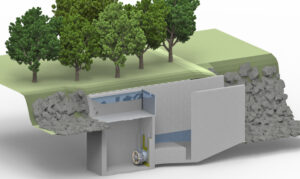
The ‘submerged’ power plant
Implementation of a modular shaft power plant is now planned for the demonstration plant in Kyrgyzstan. The power plant set-up was developed and patented by the TU Munich, and is essentially the basis for a new type of power plant system. A vertical shaft is installed in the riverbed to link up with an existing dam or new weir, and covered by a horizontal rake with integrated rake cleaning technology. The works water flows vertically down the shaft where it flows into and drives the turbine-generator unit. No noise is generated as the electromechanical equipment is fully submerged. The weir remains under water on a permanent basis. A suction pipe through the weir body establishes a connection to the tailwater section. All technical infrastructure has been trimmed to optimise maintenance. Fish descend directly into the cushion of calmer water via special openings in the gate, the sizes of which are adjusted by means of electric drives. Extremely narrow rake-bar spacing on the fine rake screen is an effective means of preventing fish from entering the turbine shaft. Being arranged along the river, there is no need for drainage diversion, and the considerable construction work and negative environmental impacts this entails. (For more information – go to the TU Munich website). Its undisputed ecological advantages, combined with the capacity to exploit low-head sites with a maximum fall of 1.2m, open up interesting perspectives for the shaft power plant worldwide, thus also for Global Hydro – the Upper Austrian plant manufacturer responsible for the centrepiece of the power plant. “We have customised the turbine for this application, making it compact, robust and, due to the absence of oils or lubricants, extremely environmentally friendly; one that requires very littlemaintenance”, summarises Thomas Eder, Head of Production and Product Development at Global Hydro.
The bigger picture
“Development of the double-regulated Kaplan turbine wasn’t over for Global Hydro’s engineers with the realisation of a submerged machine unit for the shaft power plant”, Thomas Eder confirms. Continued developments and functional enhancements are still being implemented. Ultimately, Global Hydro’s aim was to push ahead even further with the consistent expansion of its portfolio in the low-head sector; the focus here being less on individual aspects, and more on the bigger picture overall. Thomas Sageder explains the initial situation: “How can low-pressure systems be economically viable, keeping an eye on the costs of the system overall? How can existing infrastructure be used as simply and effectively as possible? These were questions we asked ourselves as we continued to develop the Kaplan EVO”, and added: “Machine super-efficiency does not necessarily amount to the best solution for the customer. Of course, customers at many sites can imagine installing a ‘highly-sophisticated’ bulb turbine with peak efficiencies, but what’s the benefit for operators if the infrastructure required means they will only see a return on investment after 40 years? We look at the total costs of investment. These must be reasonably proportionate to annual production. That’s the key.” For those responsible at Global Hydro, it goes without saying that the new EVO-series machines don’t hold back when it comes to good efficiency. Thomas Eder expands: “We tend to be conservative when it comes to claiming machine efficiency levels. Nevertheless, the turbines in the EVO series all have peak efficiencies over 90%.”
Turbine lubricated with ambient water
So how does it differ to the conventional double-regulated Kaplan turbine? “The most important point is probably its submerged operation. The Kaplan EVO is designed for underwater use and all the associated consequences. We haven’t sealed the rotating components, despite it being completely submerged. The machine is water-lubricated throughout, requiring neither oils nor other lubricants, as this function is served by the ambient water,” says Thomas Eder. Water lubrication is by no means new territory for Global Hydro engineers. Thomas Sageder points out that the company has many years of experience in this field. “So far, we had only used specially filtered water from our own water treatment unit, but in the case of the Kaplan EVO we went a step further, using ambient water cleaned of particles and suspended matter via a self-cleaning mechanical filter.” This solution also differs from the conventional Kaplan turbine in that all the actuators on the turbine are electrically and not hydraulically driven. Furthermore, the speed-controlled generator is located in the turbine housing, making it a part of the overall turbine unit.
Development team pays off
The new Kaplan EVO was developed by the HydroLab team, as Global Hydro’s development department is called, working in close cooperation with universities and research institutes. A great deal of practical experience is incorporated on top of the theoretical principles. Interdisciplinary thought is encouraged within this framework at Global Hydro. “We categorise ourselves as water-to-wire providers. As turbine manufacturers, we supply the technological centrepiece of a plant, which puts us in a position to steer decisive factors as regards the economic efficiency of a power plant – a quality also appreciated by our customers”, explains Global Hydro Managing Director Richard Frizberg, who points out that several patents have now been secured for the Kaplan EVO.
Unique ease of maintenance
One key goal of the development work was to improve ease of maintenance; a goal achieved instyle, as Thomas Sageder affirms: “If maintenance or service work is required, the entire mechanical unit can be extracted from the water via a rail system. It can be raised with a single lift, and serviced from a walk-on platform. I’ve never seen this degree of simplicity with any other type of system.” Another goal for the HydroLab team’s engineers was to enhance the installability of the machine unit. “The unit is pre-assembled, tested and delivered to the construction site in one piece, so it can be installed within a few days. Mechanical installation time is estimated at around two weeks, with an extra week required for the commissioning process. Of course, being able to install a machine quickly makes a significant contribution to the economic efficiency of a power plant project”, adds Thomas Eder. In terms of controllability, the new Kaplan EVO is fully compatible with Global Hydro’s most highly-advanced control systems, such as Heros 4.0 and Heros Connect. The entire system can be monitored and controlled via the worldwide SCADA system, so customers don’t have to fear restrictions to functionality.
Minimal construction work required
In addition to use in the shaft power plant, the new Kaplan EVO is ideally suited to various low-head applications – on existing transverse structures, in the field of refurbishment, at small inactive power plants, and in channels or at mill sites. “The huge advantage is that relatively little construction work is required”, states Thomas Sageder. The range of five different impeller sizes, from 800mm to 1,600mm, can serve head levels from 1.50m to 12.00m and various flow rates. “Nevertheless,” Thomas Eder explains, “we check the impeller geometry in advance for every project, and adapt it as required. The key question is whether to install a 3-, 4- or 5-blade impeller.” An additional quality lies in the potential modularity of the Kaplan EVO, as both operational and commercial advantages can most certainly be gleaned by arranging two modular Kaplan EVOs, optimised to the discharge curves of the watercourse.
The aim is to find the simplest solution
“In our opinion, the Kaplan EVO can be clearly regarded as an expansion of the low-head sector portfolio. It provides the basis for low-pressure applications to become economically viable again. It’s not about the cheapest solution; it’s about finding the one that makes the most economic sense for the customer” argues Richard Frizberg. As a result, the prospects are very promising for the Kaplan EVO. The technical principle behind the machine has been market-ready for some time. The first prototype for the shaft power plant is currently being manufactured in Kyrgyzstan and installation will be complete by the end of 2023. In the meantime, Global Hydro has already received initial enquiries for sites with natural gradients along lower-volume bodies of water; places where electricity can be generated with very simple constructions that don’t interfere with the environment to any great extent. Thomas Eder explains: “We have already received the concrete project enquiries, especially from Scandinavia, and with the Kaplan EVO we believe we are hitting the right notes.
Share:



